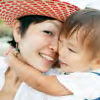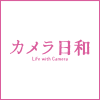When kids get to the age where they start running around, you also get an even wider range of possible photo variations. If you pay attention to angles in photography, you will be able to easily capture pictures that differ from the normal perspective. In this article, I will discuss how you can change the impression a photo gives by varying your angle. (Edited by: Camera Biyori, Photos by: Shino Chikura)

Let’s challenge ourselves by shooting from low and high angles!
A low angle shot taken with a low shooting posture pointing upwards captures the natural expression of a kid from the height of their eyes, and makes it easy to take pictures with a sense of realism and impact. Conversely, a high angle shot taken above eye-level looking downwards emphasises the child's cute and petite nature, and is also good for capturing minimalistic backgrounds.
The recommended shooting mode is < P > (Program Auto Exposure)
If you shoot in the < P > (Program Auto Exposure) mode, the camera will automatically decide the appropriate aperture value (f-number) and shutter speed for the scene. This way, you are sure to capture pictures that will satisfy you. In addition, when the ISO speed is set to [AUTO], the camera will automatically set the brightness to the optimal value to suit the scene so even beginners will have no problem shooting as well.
Also, I would recommend shooting with positive exposure compensation when photographing children as they will appear more lively. Let's make it a point to set the positive exposure compensation to your preferred brightness before shooting.
"Blowing dandelions!"

[Shooting Conditions]
Shooting location (weather): Outdoor (sunny)
Lighting condition: Backlight
EOS 750D/ EF-S18-55mm f/3.5-5.6 IS STM/ FL: 18mm/ f/3.5/1/250 sec/ISO 400/WB: Auto
Dandelion fluff is surprisingly sturdy, so I focused on the expression of my daughter trying her best to blow them away. “Come on! Blow harder! ” “Look, there’s more over there! Try it one more time!” Calling out here and there, I took the shot while trying to coax her on. Taken with a low angle shot while looking up from the bottom, this photo emphasises my child's puffy cheeks. By placing the sky in the background, the picture also evokes a refreshing and open feeling.
"Cookie making"

[Shooting Conditions]
Shooting location (weather): Indoor (sunny)
Lighting condition: Light is shining from the left side of the screen
EOS 750D/ EF-S55-250mm f/4-5.6 IS STM/ FL: 79mm /f/4. 5/ 1/100 sec)/ ISO 1600/ WB: Auto
This picture shows my daughter having fun baking cookies. The lined-up cookies cannot be seen if the shot is taken horizontally, so I used a high angle shot instead. It is best to shoot from a high angle when you want to capture items on the table at the same time.
"Little Shizuku & Hibiki"

[Shooting Conditions]
Shooting location (weather): Outdoor (cloudy)
Lighting condition: Light surrounds the entire location
EOS 750D/ EF-S18-55mm f/3.5-5.6 IS STM / FL: 28mm/ f/5.0/ 1/320 sec/ ISO 200/ WB: Auto
When I brought my kids to an open field nearby to play, they started to pick flowers quietly. So I called out to them, “Isn't that flower beautiful! There’s more blooming over there as well!”, while trying to capture their various movements. I wanted to continue shooting, but they were starting to get tired of picking flowers. So I had to coax them, “Mummy would like some flowers as well. Would you pick them for me too?” or “Wow, your flower crown is so lovely. Why don’t you put it on your sister’s head?” In this particular situation, I had to play with the kids and keep them interested while photographing them. Since kids tend to get tired of something easily, the trick is to make them excited! I managed to capture my kids playing in the vast greenery with a somewhat high angle shot.
[TIP] Shoot in a variety of angles with the tilting rear LCD screen!

High angle

Low angle
There are 2 ways to use the tilting rear LCD screen. One is to simply tilt it up or down while the other is to pull the vari-angle screen out and rotate through any angle. Regardless, both ways allow for shots to be taken easily from a low or high angle. When taking low angle shots, pull out the screen and turn it to face upwards, while squatting down to shoot. When taking high angle shots, turn the screen to face downwards, and extend your hand upwards to shoot. Since camera shake occurs easily when shooting at a high angle, hang the strap around your neck and securely fasten it to stabilise the camera.

EOS 750D Kit (EF-S18-55mm IS STM)

Photographer and mother of two girls, one aged 4 and the other, a 1-year-old. After graduating from university, she went to Germany to study under Andre Rival and Ulrike Schamoni before going independent.

Camera Biyori is a Japanese photography magazine introducing charming photos and daily joy with cameras. Suggesting fun activities relating to cameras and photography, Camera Biyori editorial department also offer the "Camera Biyori Photography School" to recommend its readers to engage in photography and have fun.
Published by Daiichi Progress Inc.

































